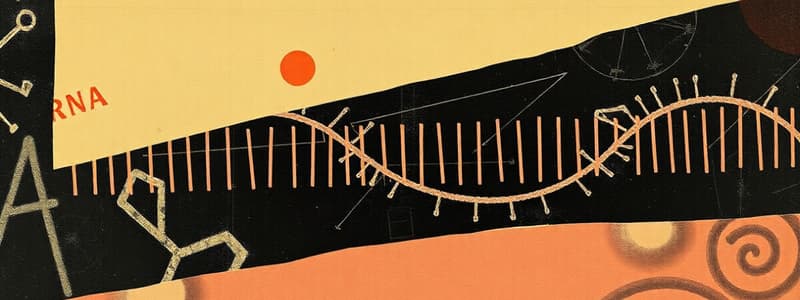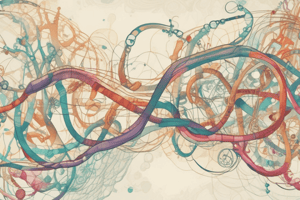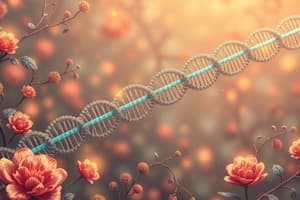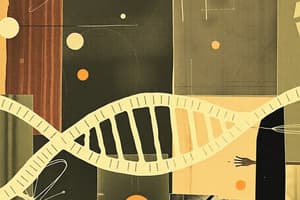Podcast
Questions and Answers
What is a key difference between transcription and replication?
What is a key difference between transcription and replication?
- Replication is selective to one gene.
- Transcription does not require a primer. (correct)
- Replication occurs in eukaryotic cells only.
- Both processes synthesize RNA.
Which characteristic is unique to RNA polymerase compared to DNA polymerase?
Which characteristic is unique to RNA polymerase compared to DNA polymerase?
- RNA polymerase requires a primer.
- RNA polymerase synthesizes DNA.
- RNA polymerase has proofreading activity.
- RNA polymerase has no exonuclease activity. (correct)
What type of modifications occur after transcription?
What type of modifications occur after transcription?
- Only methylation occurs.
- Post-transcriptional modifications are involved. (correct)
- No modifications occur post-transcription.
- All genes undergo replication modifications.
Which of the following is NOT a feature of RNA polymerase?
Which of the following is NOT a feature of RNA polymerase?
How does termination of transcription primarily occur?
How does termination of transcription primarily occur?
What is the role of the Rho factor during RNA transcription termination?
What is the role of the Rho factor during RNA transcription termination?
Which of the following correctly describes p-independent termination of transcription?
Which of the following correctly describes p-independent termination of transcription?
During the initiation phase of transcription in prokaryotes, which component is essential for the binding of RNA polymerase to DNA?
During the initiation phase of transcription in prokaryotes, which component is essential for the binding of RNA polymerase to DNA?
Which antibiotic inhibits RNA synthesis by binding to the β subunit of prokaryotic RNA polymerase?
Which antibiotic inhibits RNA synthesis by binding to the β subunit of prokaryotic RNA polymerase?
What happens to the RNA transcript after it forms a hairpin loop during transcription termination?
What happens to the RNA transcript after it forms a hairpin loop during transcription termination?
What is the primary action of RNA polymerase during the elongation phase of transcription?
What is the primary action of RNA polymerase during the elongation phase of transcription?
In p-dependent termination, what specific sequence does the Rho factor recognize?
In p-dependent termination, what specific sequence does the Rho factor recognize?
What is the role of the TATA box in transcription initiation?
What is the role of the TATA box in transcription initiation?
What is the purpose of the transcription bubble created during the initiation of transcription?
What is the purpose of the transcription bubble created during the initiation of transcription?
Where is the TTGACA box located in relation to the transcription start point?
Where is the TTGACA box located in relation to the transcription start point?
Which statement accurately describes the process of transcription elongation?
Which statement accurately describes the process of transcription elongation?
What initiates the elongation phase of transcription?
What initiates the elongation phase of transcription?
What differentiates RNA polymerase from DNA polymerase during transcription?
What differentiates RNA polymerase from DNA polymerase during transcription?
What is the primary outcome of reaching a termination signal during transcription?
What is the primary outcome of reaching a termination signal during transcription?
Which factor is crucial for the RNA polymerase to recognize promoter sites?
Which factor is crucial for the RNA polymerase to recognize promoter sites?
What is the first nucleotide that is typically transcribed in the elongation phase?
What is the first nucleotide that is typically transcribed in the elongation phase?
What is the role of the template strand during transcription?
What is the role of the template strand during transcription?
Which of the following statements is true regarding RNA synthesis?
Which of the following statements is true regarding RNA synthesis?
What are the three types of RNA found in prokaryotic and eukaryotic cells?
What are the three types of RNA found in prokaryotic and eukaryotic cells?
Which phase of transcription involves the addition of ribonucleotides to the growing RNA chain?
Which phase of transcription involves the addition of ribonucleotides to the growing RNA chain?
In eukaryotic genes, which of the following describes the role of introns?
In eukaryotic genes, which of the following describes the role of introns?
What is the primary enzyme responsible for RNA synthesis during transcription?
What is the primary enzyme responsible for RNA synthesis during transcription?
What distinguishes the coding strand from the template strand?
What distinguishes the coding strand from the template strand?
Which base pairing relationships are correct during RNA synthesis?
Which base pairing relationships are correct during RNA synthesis?
What is a primary reason eukaryotic transcription is more complex than prokaryotic transcription?
What is a primary reason eukaryotic transcription is more complex than prokaryotic transcription?
Which transcription factor is responsible for recognizing the TATA box in the promoter region?
Which transcription factor is responsible for recognizing the TATA box in the promoter region?
What is the role of transcription factors in the transcription process of eukaryotes?
What is the role of transcription factors in the transcription process of eukaryotes?
What is the typical location of the CAAT box in eukaryotic promoters?
What is the typical location of the CAAT box in eukaryotic promoters?
How does amanitin affect RNA polymerase II during transcription?
How does amanitin affect RNA polymerase II during transcription?
What is the significance of the GC box in eukaryotic promoters?
What is the significance of the GC box in eukaryotic promoters?
Which of the following statements about eukaryotic RNA polymerase II is true?
Which of the following statements about eukaryotic RNA polymerase II is true?
What differentiates eukaryotic transcription factors from prokaryotic mechanisms?
What differentiates eukaryotic transcription factors from prokaryotic mechanisms?
What role does TFII H play in the transcription process?
What role does TFII H play in the transcription process?
During the elongation phase of transcription, the RNA polymerase synthesizes RNA in which precise direction?
During the elongation phase of transcription, the RNA polymerase synthesizes RNA in which precise direction?
What is the significance of the AAUAAA sequence in RNA transcription termination?
What is the significance of the AAUAAA sequence in RNA transcription termination?
What modification occurs at the 5' end of eukaryotic mRNA?
What modification occurs at the 5' end of eukaryotic mRNA?
What distinguishes eukaryotic transcription from prokaryotic transcription?
What distinguishes eukaryotic transcription from prokaryotic transcription?
Which of the following statements about the removal of introns is correct?
Which of the following statements about the removal of introns is correct?
Which class of RNA is NOT directly produced by RNA polymerase during transcription?
Which class of RNA is NOT directly produced by RNA polymerase during transcription?
What effect does actinomycin D have on RNA transcription?
What effect does actinomycin D have on RNA transcription?
Flashcards
Transcription
Transcription
The process of creating RNA from a DNA template.
Template Strand (DNA)
Template Strand (DNA)
The DNA strand used as a pattern to create the RNA.
Coding Strand (DNA)
Coding Strand (DNA)
The DNA strand that is similar to the created RNA.
RNA Polymerase
RNA Polymerase
Signup and view all the flashcards
Gene
Gene
Signup and view all the flashcards
Gene Expression
Gene Expression
Signup and view all the flashcards
Transcription Steps
Transcription Steps
Signup and view all the flashcards
mRNA, rRNA, tRNA
mRNA, rRNA, tRNA
Signup and view all the flashcards
Transcription Termination
Transcription Termination
Signup and view all the flashcards
ρ-Independent Termination
ρ-Independent Termination
Signup and view all the flashcards
ρ-Dependent Termination
ρ-Dependent Termination
Signup and view all the flashcards
Palindromic Sequence
Palindromic Sequence
Signup and view all the flashcards
Rifampicin's Action
Rifampicin's Action
Signup and view all the flashcards
Transcription Bubble
Transcription Bubble
Signup and view all the flashcards
RNA Polymerase Holoenzyme
RNA Polymerase Holoenzyme
Signup and view all the flashcards
Sigma Factor
Sigma Factor
Signup and view all the flashcards
Pribnow box
Pribnow box
Signup and view all the flashcards
TTGACA box
TTGACA box
Signup and view all the flashcards
Transcription Initiation
Transcription Initiation
Signup and view all the flashcards
Transcription Elongation
Transcription Elongation
Signup and view all the flashcards
Sigma Subunit
Sigma Subunit
Signup and view all the flashcards
Holoenzyme
Holoenzyme
Signup and view all the flashcards
Eukaryotic Transcription
Eukaryotic Transcription
Signup and view all the flashcards
Transcription Factors
Transcription Factors
Signup and view all the flashcards
CAAT Box
CAAT Box
Signup and view all the flashcards
GC Box
GC Box
Signup and view all the flashcards
TFII D
TFII D
Signup and view all the flashcards
Amanitin's Effect
Amanitin's Effect
Signup and view all the flashcards
Eukaryotic Transcription Complex
Eukaryotic Transcription Complex
Signup and view all the flashcards
Replication vs. Transcription
Replication vs. Transcription
Signup and view all the flashcards
Primer Requirement
Primer Requirement
Signup and view all the flashcards
Polymerase Differences
Polymerase Differences
Signup and view all the flashcards
TFII F's Role
TFII F's Role
Signup and view all the flashcards
TFII H's Double Duty
TFII H's Double Duty
Signup and view all the flashcards
Transcription Starts Where?
Transcription Starts Where?
Signup and view all the flashcards
RNA Elongation Process
RNA Elongation Process
Signup and view all the flashcards
RNA Transcript Similarity
RNA Transcript Similarity
Signup and view all the flashcards
Termination Signal
Termination Signal
Signup and view all the flashcards
Splicing Out Introns
Splicing Out Introns
Signup and view all the flashcards
5' Cap Purpose
5' Cap Purpose
Signup and view all the flashcards
Poly (A) Tail for Stability
Poly (A) Tail for Stability
Signup and view all the flashcards
Eukaryotic vs. Prokaryotic Transcription
Eukaryotic vs. Prokaryotic Transcription
Signup and view all the flashcards
Dactinomycin's Blocking Action
Dactinomycin's Blocking Action
Signup and view all the flashcards
Study Notes
Transcription Overview
- Transcription is the process of synthesizing RNA from a DNA template.
- Specific DNA sequences (genes) are copied into RNA.
- DNA-dependent RNA polymerase is the enzyme that catalyzes this process.
- The process occurs in the cytoplasm of prokaryotes and in the nucleus of eukaryotes.
Steps in Transcription
-
Initiation: RNA polymerase binds to a specific DNA region, called a promoter. Promoter sequences, such as the TATA box (Pribnow box), are crucial in initiation. The promoter area helps select the start site of RNA synthesis. The RNA polymerase binds to the promoter and begins to unwind the DNA double helix.
-
Elongation: RNA polymerase moves along the template strand, adding RNA nucleotides complementary to the DNA template strand. The RNA is synthesized in the 5' to 3' direction, and uses nucleoside triphosphates as substrates.
-
Termination: RNA synthesis stops at a termination signal on the DNA template. This can occur spontaneously (intrinsic termination), or involve a protein factor called Rho (rho-dependent termination).
Prokaryotic Transcription
- Prokaryotes have a single RNA polymerase that synthesizes all types of RNA.
- The RNA polymerase is a holoenzyme complex, consisting of a core enzyme and a sigma factor.
- The sigma factor is involved in promoter recognition. Specific promoter sequences, like -10 and -35 regions, in the promoter are important for sigma factor binding.
- Termination signals cause the release of the RNA transcript.
Eukaryotic Transcription
- Eukaryotes have three distinct RNA polymerases (I, II, and III) that synthesize different types of RNA.
- RNA polymerase II is responsible for mRNA synthesis.
- Transcription often involves numerous transcription factors. These factors act as regulatory proteins, helping determine which genes are transcribed.
- Several specific sequences exist in the promoter region, unique to eukaryotes, such as the TATA box, CAAT box, and GC boxes, that the transcription factors bind to.
- Common eukaryotic transcription factors include TFII A, B, D, E, F, and H.
- Termination in eukaryotes is less simple than in prokaryotes, and occurs at specific signals.
Post-transcriptional Modifications
- Eukaryotic RNA transcripts undergo significant modifications after transcription.
- RNA splicing removes introns (non-coding regions) and joins exons (coding regions).
- Capping occurs at the 5' end of the mRNA. A 7-methylguanosine cap protects the mRNA.
- Polyadenylation adds a poly(A) tail to the 3' end of the mRNA. The poly(A) tail also protects the mRNA from degradation.
Inhibitors of Transcription
- Some antibiotics, such as Rifampin, inhibit prokaryotic RNA polymerase activity by interfering with the formation of the first phosphodiester bond as well as the initial stage of the transcription process.
- Amanitin, a toxin from poisonous mushrooms, inhibits eukaryotic RNA polymerase II.
Comparing Replication and Transcription
- Replication involves copying the entire genome, while transcription copies only specific genes or groups of genes.
- Transcription uses RNA polymerase, while replication uses DNA polymerase.
- Transcription does not require a primer or proofreading, while replication does.
- Transcription produces a single-stranded RNA molecule. Replication produces double-stranded DNA molecule.
Studying That Suits You
Use AI to generate personalized quizzes and flashcards to suit your learning preferences.




